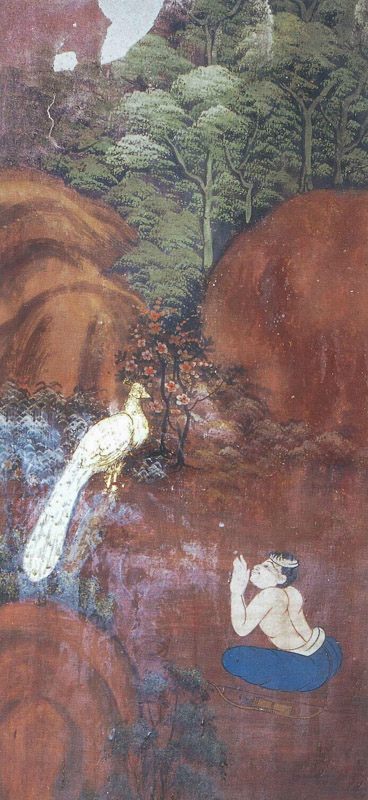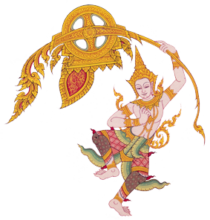
The Bodhisatta was once a golden peacock, the leader of his flock. One day, seeing his reflection in a pool of water, he thought he was the most beautiful of all peacocks and realized that if he remained in the human realm, he would someday fall into danger. So that night, without telling anyone, he snuck away to the Himalayas, settling in a distant cave that was impossible to climb to, either from below or above.
Every morning at sunrise, and again at sunset, the Bodhisatta sat on a hilltop and recited two protection spells in worship of the sun. A hunter once saw the Bodhisatta sitting there, and on his deathbed told his son about it, just in case the king ever wanted to have a golden peacock.
Not long after the hunter died, the chief queen dreamed that she sat listening to a golden peacock preach; and when she awoke, she longed to have this in real life. Knowing that if she just told the king of her dream he wouldn’t care, she pretended to be pregnant and told him this was one of her cravings; and she would die if she did not get her wish.
When the king’s chaplains assured him that such creatures existed, he assembled all the hunters from across the kingdom and asked if any of them knew of a golden peacock. Only the man informed by his deceased father answered, and the king gave him money and sent him out to capture it.
The hunter followed his father’s directions and found the Bodhisatta. Day after day, the hunter set snares on the hilltop, but the Bodhisatta was protected by his daily chants, and even when he stepped into one it wouldn’t close. The hunter died without ever capturing the Bodhisatta, and then the queen died of grief over her wish going unfulfilled. Angry with the Bodhisatta, the king wrote an inscription on a golden tablet telling people that a magical golden peacock lived in the Himalayas’ fourth range and anyone eating it would be forever young and immortal.
The next king read the tablet. Wanting immortality, he sent a hunter to the forest, but the quest for a golden peacock proved equally futile for him and the next four kings. After seven years, the hunter sent by the seventh king wondered why he had no success. So he watched the Bodhisatta throughout the day and saw that he did morning and evening prayers. Now that the hunter knew it was tremendous holiness counteracting the snares, he came up with a new plan. He caught a peahen and trained it to dance when he clapped his hands and cry out when he snapped his fingers, and he took it to the hilltop early in the morning. When the Bodhisatta arrived, the hunter snapped his fingers. Upon hearing the peahen’s song, the Bodhisatta was seized by lust for the first time in seven thousand years. Instead of reciting his spells, he went off to find the female and got caught in a snare.
The hunter instantly regretted what he had done and decided to set the Bodhisatta free. In order to not frighten the Bodhisatta, which could cause him to break a leg or wing while struggling to get away, the hunter was going to cut the snare from a distance with an arrow. Just as the hunter drew his bow, the Bodhisatta spied him in the trees and begged to be taken to the king alive. The hunter explained what he was actually doing, and then the two discussed the nature of virtue so profoundly that the hunter became a private Buddha (those who reach enlightenment on their own and do not teach the path to others).
Concerned about birds encaged back at his home, the hunter spoke an act of truth (a solemn declaration of one’s supreme virtue followed by a request for some miraculous result), and not only were his many hundreds of birds set free, but so was every captive creature in all of India. The hunter then flew off to Nandamula Cave to live out his life, and the Bodhisatta remained in his same home.
In the Lifetime of the Buddha
One of the Buddha’s disciples began lusting for a woman, and the Buddha told him this story to show how he himself had suffered this problem in the past but was able to overcome it. Upon hearing the story, the disciple became an arahant.
The Buddha did not identify any earlier births other than his own.
